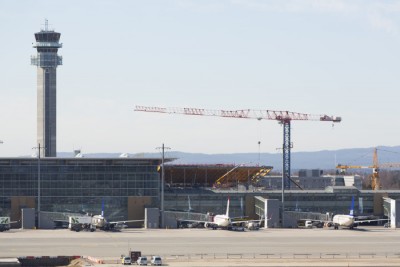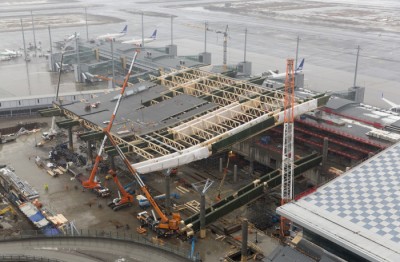A major expansion of Oslo’s main airport at Gardermoen (OSL) is costing much more than initially planned, and that’s uncorked more debate over soaring duty-free sales. Airport officials admit they’re relying on even more sales of “tax-free” items to help fund the expansion, while others claim the entire duty-free system undermines Norwegian policies aimed at curbing alcohol consumption.

When OSL opened in October 1998 to replace Oslo’s old airport at Fornebu (FBU), it was widely viewed as “an airport for the next century.” Vastly expanded in comparison to FBU and lying in a far more open area northeast of the city, OSL was lauded for its architecture, its stylish use of wood and glass and, not least, its capacity.
Just 12 years later, the capacity at the airport that many Norwegians still consider to be “new” had burst. Increased affluence among traveling Norwegians, increasing numbers of foreign travelers to Norway and a huge increase in the number of airlines and flights in and out of Gardermoen prompted the state-owned airports administrator Avinor to launch a major expansion in 2010. Construction of a new terminal, check-in and security areas began the year after.
Newspaper Dagens Næringsliv (DN) reported during the weekend that the cost of expanding OSL, initially budgeted at NOK 6 billion-8 billion, has since doubled, to at least NOK 14 billion. Retiring airport boss Ingar Nicolai “Nic” Nilsen attributed the higher costs to a lack of competitive bids from busy building contractors, at a time of other major construction projects in Norway, plus the unexpected discovery of groundwater under the construction area. Nilsen said the biggest cost factor, however, has been the expense of improvising temporary facilities to handle passengers and flights during the construction process.
“It’s expensive to operate an airport and a construction project at the same time,” Nilsen told DN.

What’s since set off controversy isn’t so much the budget overruns but how airport officials intend to cover them. Nilsen and Avinor boss Dag Falk Petersen stress that the project is “fully financed” and Petersen downplayed the cost increase on Monday. He contended that despite estimates of NOK 6 billion to 8 billion reported to media in 2010, the project had a framework of NOK 12.5 billion already in 2011 and that was boosted to NOK 13.45 billion last year. “Given the revised budget from June 2013, we’re on track,” Falk-Petersen told DN on Monday.
OSL officials intend to cover the costs through sales of even more food, drink, services and merchandise at the airport. Nilsen told DN on Saturday that every passenger currently spends an average of NOK 120 at the airport. Nilsen thinks that can double when the expanded airport opens in 2017, because of higher passenger counts and the additional space that will be devoted to retail sales.
The biggest chunk of retail sales comes through OSL’s duty-free operation, where sales of otherwise highly taxed tobacco, alcohol, perfume, cosmetics, chocolate and other candy are run by Travel Retail Norway. It’s jointly owned by Gebr. Heinemann of Germany, Validus of Norway and Norway’s dominant grocery store owner NorgesGruppen.

Petersen agrees that increased duty-free sales are “a natural consequence” of the airport’s expansion and he defends them vigorously. Not only will duty-free sales revenues offset the costs of OSL’s expansion, they also indirectly subsidize Avinor’s operation of unprofitable airports in Norway’s outlying districts. “Avinor finances the airports that operate at a loss with profits from the biggest airports,” Petersen told DN. “We also pay taxes to the state and turn over a dividend of around a billion kroner a year. All our revenues go towards our job of providing good infrastructure for safe and adequate aviation in Norway.”
Vinmopolet feels threatened again
That didn’t stop Kai G Henriksen, chief of the state wine and liquor monopoly that long has aimed to control and highly tax alcohol sales in Norway, from crying foul again on Monday. He complains that ever-increasing sales of duty-free alcohol undermines Norwegian alcohol policies and the very existence of Vinmonopolet.
“If duty-free sales double in Norway, it will mean that every fourth bottle of wine and liquor that’s consumed in Norway will have been bought tax-free,” Henriksen told DN. “Then you have to ask, what’s the point of having a state monopoly?”
Henriksen fears Vinmonopolet stands to lose even more business to the duty-free system, and that a doubling of duty-free sales will boost alcohol consumption in Norway. “I can hardly believe that a state-owned entity (Avinor) will so clearly state that they want to increase alcohol consumption in Norway,” Henriksen said. “As I see it, this violates the broad political agreement in Norway (to limit consumption). Now it’s high time to clarify just how Norway’s alcohol policies shall be carried out.”
Battles loom
A battle over the future of the Vinmonopolet already looms, with several politicians and media commentators have already been calling for a reduction in duty-free sales, or even abolition of the entire system in return for lower taxes on Vinmonopolet sales. Norway’s new conservative government, however, indirectly boosted the potential for more sales by increasing the tax-free liquor quota for those who don’t use their tobacco quota.
It’s a political hornets’ nest, since many Norwegians embrace their duty-free quotas and duty-free sales also help finance the ferries that run between Norway, Denmark and Sweden. Few politicians seem willing to risk angering voters, and even the restrictive, rural-friendly Center Party will have a hard time fighting against a system that effectively subsidizes airports in outlying areas. Many other players are involved, from the retailers to transport firms, but calls for debate in parliament are louder than ever.
newsinenglish.no/Nina Berglund

